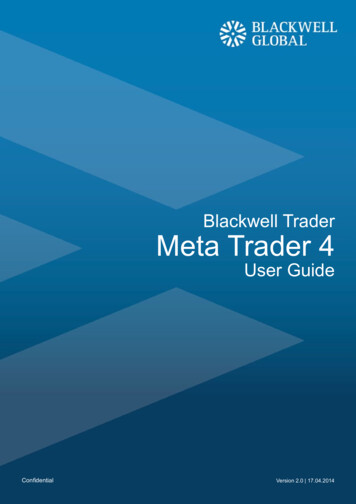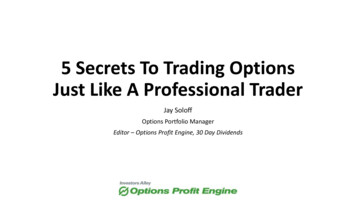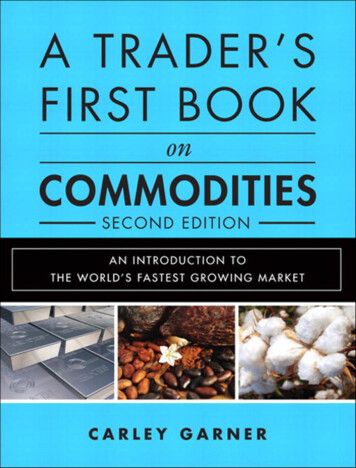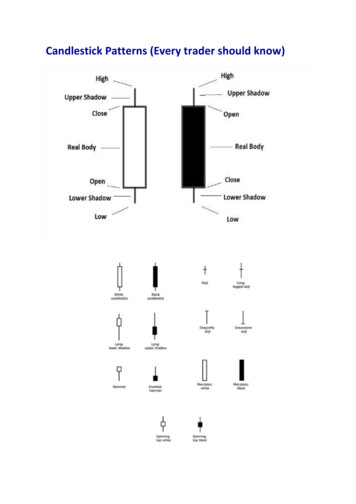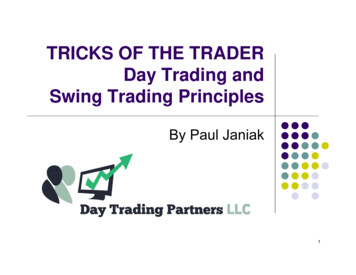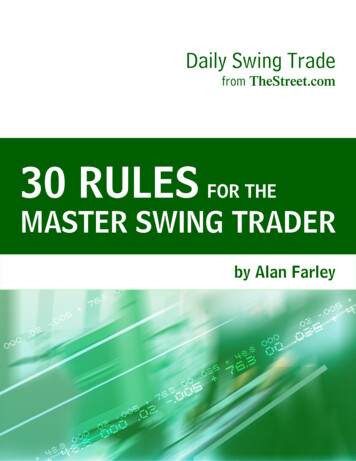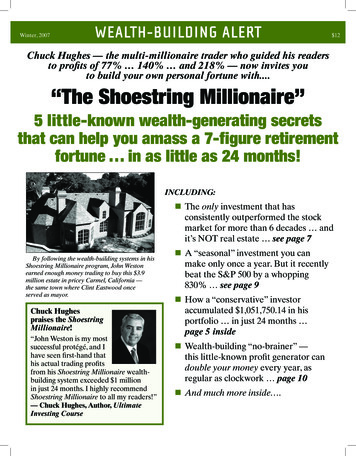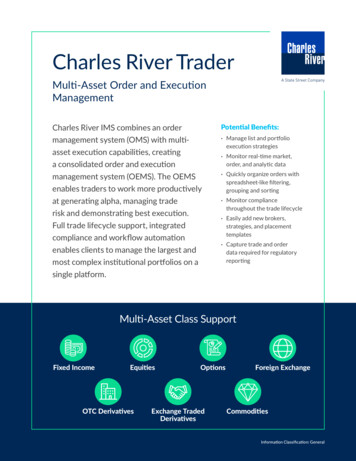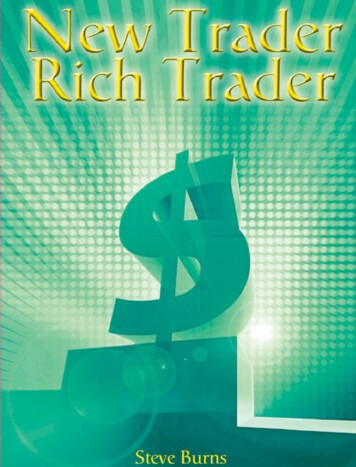
Transcription
New Trader,Rich Trader:How to MakeMoney in theStock MarketBy: Steve BurnsWith Janna Burns
Reviews for
"How I Made Money Usingthe Nicolas Darvas System"Steve Burns wants you to follow thetrend and make money. That is a goodthing. Listen up! – Michael W. Covel,bestselling author of "Trend Following"& "The Complete Turtle Trader"Awesome work! This quick read is full
of golden nuggets of market wisdomand I encourage everyone to learn fromthose who have been thissuccessful.Darvas and Burnsalike.this is a must read to add to anytrader or investor's arsenal! – TimothySykes, author of "An American HedgeFund"Go read Steve’s book, “How I MadeMoney Using the Darvas System.” It’sa fast read, purposely kept as simple aspossible, so that even total newbies canunderstand it. And, it shows a real-lifeexample of how you can use the Darvas
System to make big money and trulychange your life for the better. –Darrin Donnelly, “DarvasTrader.com”This book is powerful because itsimplifies a subject that many peoplefind hard to understand. This bookoffers people a clear strategy forbecoming financially free. – KeithCameron Smith, Author of "The Top 10Distinctions between Millionaires andthe Middle Class"
This book is essential reading forDarvas followers. I have read all of theDarvas books in print and Steve Burns’book not only uses all Darvas'techniques but compliments andconfirms what Darvas has done usingreal examples and making real money.– Fred Chen, Amazon.com ReviewerThis book reminds us all that it's notenough to make money in the market, ifyou don't keep the money you make.Steve Burns gives time tested and lifetested instruction in how to make sure
you keep the money you make in themarket. – C. Oliver, Amazon.comReviewer, Vine Voice
New Trader,Rich Trader
Also by Steve Burns:How I Made Money Using theNicolas Darvas System
New Trader,Rich Trader:How to MakeMoney in theStock MarketBy: Steve Burns
With Janna Burns
All rights reserved.No part of this publication may bereproduced, stored in a retrievalsystem, or transmittedin any form or by any means,electronic, mechanical,photocopying or otherwise, withoutthe prior permission of
the copyright owner.info@bnpublishing.netwww.bnpublishing.netALL RIGHTS RESERVED
For information regarding specialdiscounts for bulkpurchases, please contact BNPublishing at sales@bnpublishing.net
IntroductionThe purpose of this book is toshare with readers theprinciples of successfultrading: methodology, riskmanagement, andpsychology. New tradersusually learn these the hardway, by losing money.When a new trader entersthe stock market with
money but no experience,the odds are he will quicklygain experience by losingmoney.This book was writtento give new traders a headstart in the markets. Withonly about one in 10 tradersactually making money in themarket, I believe this bookcan increase these oddssubstantially. It is critical to
begin trading with a soundmethodology which gives youan advantage over themarkets. But even moreimportant is the trader’sability to take losses andpersevere through the rougheducation that will ensue.You will be competing withother traders whose only goalis to make money. Profits aremade by being on the rightside of the trade.
Unfortunately, new tradersfind themselves on the wrongside of trades the majority ofthe time when they are firststarting out. Make nomistake: it is a journey worthtaking. The profits are therefor those who follow the rightprinciples, manage theirlosses, and run their tradinglike a business. Successfultraders made it because theypersevered through the initial
losses and learned how to winin the long term. In this bookI share with you the lessons Ilearned in the markets overthe past 12 years. Theselessons come from manysources. I learned many ofthese lessons and principlesfrom my own personalexperiences of winning andlosing. I also have read andstudied over 150 books oninvesting and trading. I have
friends and mentors who havebeen an inspiration with theirsuccesses and who I learned agreat deal from. I also havepicked up many powerfulprinciples from reading bookswritten by great traders abouttheir methods of success. Thisbook is meant to be a shortcutto the principles necessary tobe a successful trader –without having to trade for adecade, spend thousands of
hours reading, or learn thehard way by losing thousandsof dollars. It is my hope thatyou find this book helpful anduseful on your tradingjourney. I wish I had it whenI began trading.
ForewordI was thrilled when Ifirst heard Steve Burns’ story.First off, here wassomeone who not onlysurvived one of the worstperiods in the history of thestock market, but he actuallytraded his way to a six-figure
fortune during this period.But beyond the fact thatBurns thrived during such atough investors' period, Iloved learning that he wasjust a “regular guy” tradingwith his retirement account.He wasn’t some Wall Streetbig shot who managed otherpeople’s money to make hisfortune, and he wasn’t sometype of financial academic
who looked back on the rockymarket and offered ahypothetical model of whatan investor should have done.No, Steve Burns waslike most people. He had ajob, a family, and a mortgageto worry about. He wassimply interested in securinghis own financial future withwise investment decisions.But Burns was unlike
most people in that he didn’tblindly follow the traditionalbuy-and-hold “Wall Streetwisdom,” and he didn’t trusthis money in the hands ofothers. He took charge of hisfinancial future by studyingwhat actually worked andimplementing his strategy inthe simplest way possible.Burns found hisinvestment method of choice
in the trendy trading strategyknown as “The DarvasSystem.” This system wasinvented in the late 1950s bya successful ballroom dancer(read: non-Wall Streetprofessional) named NicolasDarvas who used his strategyto turn 30,000 into morethan 2 million in less thantwo years. The DarvasSystem implements a simplecharting method for riding the
upward trends of big-earninggrowth stocks and thenexiting positions when thetrend is broken.While the DarvasSystem has evolved a greatdeal over the past 60-plusyears, it has remained, at itscore, a very simple way totrade stock trends: you buy agreat stock when it breaks outof its top base, you hold it for
as long as it remains in asteady uptrend (ignoring the“normal” pullbacks along theway), and you sell it when itfinally breaks its uptrend.This very simple and proventheory is actually quitedifficult for most people tofollow due to the humanemotions and psychologicalbarriers which come withholding a stock during a longuptrend despite pullbacks.
The keys to successfultrend trading are removingyour emotions from the trade,avoiding the Wall Street“noise” and stock guru“predictions,” and keepingyour buy-and-sell rules assimple, clear, and easy toimplement as possible.Steve Burns hasmastered the keys tosuccessful trading, and in this
book he reveals the rules,techniques, and lessons thatare essential to tradingsuccess.If you’re new to thestock market, understandingthese rules will save youyears of frustration andpainful losses. If you’re aseasoned pro, consider thisthe “commandments oftrading” that need to be
repeatedly pounded into yourhead.I believe that anyonewho wants to earn big moneytrading stocks (or steadilygrow their nest egg withoutlosing big money) shouldkeep this book on their deskat all times. I see it as anessential handbook of trendtrading, and I believe ageneration of traders will be
very thankful that SteveBurns took the time to writethis wonderful book.Darrin DonnellyEditor of DarvasTrader.comMarch 2011
ContentsIntroductionForwardPart I Psychology1. New Traders are greedyand have unrealisticexpectations; Rich Tradersare realistic about theirreturns.2. New Traders make the
wrong decisions because ofstress; Rich Traders are ableto manage stress.3. New Traders are impatientand look for constant action;Rich Traders are patient.4. New Traders trade becausethey are influenced by theirown greed and fear; GoodTraders use a trading plan.5. New Traders are
unsuccessful when they stoplearning; Rich Traders neverstop learning about themarket.Part II RISK6. New Traders act likegamblers; Rich Tradersoperate like businesspeople.7. New Traders bet the farm;
Rich Traders carefully controltrading size.8. For New Traders hugeprofits are the #1 priority; forRich Traders managing risk isthe #1 priority.9. New Traders try to provethey are right; Rich Tradersadmit when they are wrong.10. New Traders give backprofits by not having an exit
strategy; Rich Traders lock inprofits while they are there.Part III Methodology11. New Traders quit; RichTraders persevere in themarket until they aresuccessful.12. New Traders hop fromsystem to system the moment
they suffer a loss; RichTraders stick with a winningsystem even when it's losing.13. New Traders place tradesbased on opinions; RichTraders place trades based onprobabilities.14. New Traders try topredict; Rich Traders followwhat the market is tellingthem.
15. New Traders trade againstthe trend; Rich Tradersfollow the market trend.16. New Traders follow theiremotions, putting them at adisadvantage; Rich Tradersfollow systems which givethem an advantage.17. New Traders do not knowwhen to cut losses or lock ingains; Rich Traders have anexit plan.
18. New Traders cut profitsshort and let losses run; RichTraders let profits run and cutlosses short.Appendix A: ResourcesAppendix B: Authortrading/investing results2003-2010Appendix C: MyRecommendations: The TopTwenty Trading Books
Appendix E: My Top TenBook Recommendations forSuccess in Life and TradingAbout the AuthorAcknowledgements
Part 1Psychology
1New Traders are greedyand have unrealisticexpectations; Rich Tradersare realistic about theirreturns.When New Trader awoke,bright and early, he could feelhis excitement building with
every moment.Booting up his computer, hecouldn’t help but rememberevery excruciating detail thatwent into building hisaccount, the many hours ofovertime at his regular joband delivering pizzas onweekends to earn some extracash.But now that part of his lifewas over. His heartbeat
quickened as he typed in hisusername and password forhis 10,000 account.He was ready.How could he not be? NewTrader had been tradingthrough simulated accountsfor over a year, watchedCNBC, and followed manytrading gurus.The way he saw it, it was
easy.When an account lost toomuch money, he simplyopened up a new one. Andwhen he made a great return,his selective memory decidedto forget the account that hadlost so much This fed his ego, convincinghim that he could easilyoutperform the market.
New Trader projected that hecould double his account in afew months, then do so againby the end of the year,bringing his account to 40,000.It wouldn’t be so hard, hethought; he had read a fewbooks about legendarytraders, so now all he had to
do was repeat what they haddone.Unfortunately for NewTrader, he either didn’t reador didn’t comprehend the factthat these very same traderssuffered losses and faceddifficulties before theiramazing successes.Many had blown up, losing50% or more of their startingcapital. Some even went
bankrupt when they didn’tcontrol their risk or brokefrom their trading plan.But unfortunately, NewTrader, who was still high onthe excitement of his shinynew 10,000 in buyingpower, could not conceiveany loss. His excitementoverruled any fear or doubtthat may have entered hismind.
New Trader was eager andhungry to trade, quicklyfamiliarizing himself with thetools. All of these were newto him: the charting software,the real time streamers, howto enter trades.So now there was only onequestion left: What to trade?First he would need a stockthat would double to help himreach his first goal, or trade a
stock for a 26% return threetimes.He knew the math; hewas always great at math inschool and was used toalways finding solutions toproblems.Trading was simplymath. And math was simplylogic. New Trader waslogical.
Or so he thought, as his headswam in the results ofcompounded returns; hewould be a millionaire in afew years, just like his tradingheroes!Actually, one of his heroes,Rich Trader, lived in the city.New Trader found himselffrequently going to the manwith questions about how tobecome a trader perhaps he
should ask him for some lastminute advice before hestarted trading not that heneeded it, of course!And that was how NewTrader found himselfknocking on his mentor’sdoor. They exchanged theirusual greeting and RichTrader let him in.“I suppose this is about thataccount of yours?” Rich
Trader said with a wry smile.This wasn’t the first timeNew Trader came to RichTrader’s home about theaccount.“I really appreciate you beingable to answer my questions,”the younger man said as RichTrader poured himself somefreshly brewed coffee, gettingNew Trader a mug as helistened.
“My plan is ” New Traderbegan speaking as soon as thecoffee was in his hand, “ todouble my account in a fewmonths, then double it againso I can build it up to 40,000to trade with next year what?”Rich Trader was looking athim with an amused grin.“Wow ” he took a sip ofcoffee. “So you’re planning
to be one of the top traders inthe world the first year youtrade? That’s a veryaggressive goal for abeginner.”“I just need to find a stockthat doubles twice, or have26% returns compounded sixtimes!” New Trader said, inthe overeager exuberanceRich Trader had come toexpect from him.
Rich Trader shook his head,the wry smile back on his lipsas he removed his glasses andrubbed his eyes, as if inthought.“Well, New Trader,” he saidafter a moment, “while thosereturns are possible, theyusually only happen duringspecial time periods – like thebooming late '20s bullmarket, or the Internet
New Trader, Rich Trader: How to Make Money in the Stock Market By: Steve Burns With Janna Burns. Reviews for "How I Made Money Using the Nicolas Darvas System" Steve Burns wants you to follow the trend and make money. That is a good thing. Listen up! – Michael W. Covel, bestselling author of "Trend Following" & "The Complete Turtle Trader" Awesome work! This quick read is full. of golden .File Size: 1MBPage Count: 677
